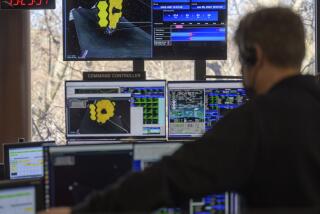Ex-Workers of Lab to Be Paid for Illnesses
Thousands of former employees who may have contracted illnesses from chemical or radiation exposure at Rocketdyne’s Santa Susana Field Laboratory are eligible to receive federal reparations beginning this month.
Before the first claims are processed, however, the new program is already generating debate.
Critics contend the program, open to current and former workers of Department of Energy sites across the country, has been poorly promoted to discourage applications.
They also say that those who do apply for as much as $150,000 in federal money and additional medical expenses could have a tough time meeting the program’s strict criteria.
But Pete Turcic, director of the Energy Employees Occupational Illness Compensation Program, said his staff is being flooded with inquiries. “We’re doing everything we can to get the word out,” he said.
Dan Hirsch, a Santa Cruz-based nuclear policy specialist and longtime Rocketdyne critic, questioned the government’s commitment.
“After half a century of the federal government denying that radiation exposure had harmed its workers, they’ve now reversed course and admitted the harm they produced,” Hirsch said.
“The concern is . . . the same federal players who resisted compensation claims for injured workers are involved in establishing the criteria for this program.”
Risk Levels Questioned
Current or former employees of federal nuclear testing and production facilities could apply to receive $150,000 and free ongoing medical coverage for certain cancers or lung diseases, if it is determined that those illnesses were at least 50% likely to have been caused by on-the-job exposure.
But with the government deciding what risk to attach to varying radiation levels, Hirsch said, “That could be a very difficult thing to demonstrate.”
He cited a recent study by UCLA researchers who asserted that radiation was perhaps 10 times as potent a carcinogen as government standards presume.
“Certainly some people will get compensation, but I worry that many workers will end up quite frustrated,” Hirsch said.
The Department of Labor, which is administering the compensation program, will evaluate claims with the help of the Department of Health and Human Services, and records from the nuclear facilities.
About 6,000 Rocketdyne employees or their survivors could be covered by the program. From the 1950s to the 1980s, workers at what is now a division of Boeing Co. performed federal nuclear testing at the Santa Susana lab near Simi Valley and at two sites in the San Fernando Valley.
As many as 60,000 people have worked at those sites through the years, but only about 10% were classified as radiation workers, company officials said Wednesday.
Many Others Are Affected
Throughout California, thousands of other workers at 20 labs, some now defunct, could be eligible. Those labs include Electro Circuits Inc. in Pasadena; the Laboratory of Biomedical and Environmental Sciences at UCLA; Ceradyne Inc. in Santa Ana; Hunter Douglas Aluminum Corp. in Riverside; and the Lawrence Livermore National Laboratory in Northern California.
Nationwide, at least 654,000 workers from 317 facilities could be covered. The program goes into effect July 31 and is expected to cost $2 billion in its first five years.
A toll-free hotline ([866] 888-3322) and a Web site https://(www.tis.eh.doe.gov/advocacy) have been set up for those seeking more information.
Former Rocketdyne secretary Bonnie Klea already has filled out the paperwork.
“There’s no amount of money that could make anyone happy about having cancer,” she said. “But it’s better than nothing. And what we had before was nothing, with the companies absolutely denying that they did any harm.”
Klea, 58, of West Hills, said she believes that although she wasn’t a radiation worker, her exposure to on-site radiation between 1963 and 1971 triggered the bladder cancer that was diagnosed in 1994. The cancer is now in remission.
After her diagnosis, Klea sought relief in workers’ compensation court, but lost. “Rocketdyne’s doctor said it wasn’t work-related, and the judge turned my case down,” she said.
Because she wasn’t classified as a radiation worker, Klea knows her case is not a slam dunk, even under the new program. But she is hopeful her chances have improved.
Before the program, sick workers had to prove the cancer was more likely than not caused by the job. Now the burden is shifted so that it’s up to the government to demonstrate the job was probably not the cause.
“That’s an important distinction,” Hirsch said. “But what that means in the real world, I think, is still to be sorted out. The fine print and regulations often leave these people dangling.”
More to Read
Sign up for Essential California
The most important California stories and recommendations in your inbox every morning.
You may occasionally receive promotional content from the Los Angeles Times.










